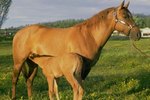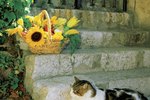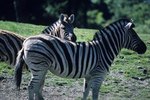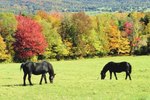Assuming you feed your horse a nutritionally balanced equine diet, complete with plenty of roughage in the form of forage -- good quality grazing grass or hay -- then her bark eating may be a sign she's bored. Or she may have an eating disorder known as pica, which is eating strange substances for no apparent reason. And it's possible she's not really eating the bark at all but is instead a cribber.
Cribbing
Your horse may be engaging in the highly addictive equine habit of cribbing. A cribber presses her teeth against an object -- trees, fence posts and stall doors are common -- and sucks air into her throat. Whether she's actually eating the bark or just pressing on it with her teeth to crib, as long as the tree, such as a pine tree, isn't toxic to horses, it will merely bear the brunt of the damage.
Tips
Schedule frequent dental checks for horses who are chronic cribbers or bark chewers.
The Diet Component
If your horse is unable to freely graze on high-quality pasture grass at will, your first task is to ensure she is getting plenty of nutritional hay or other forage. The bulk of her diet should be comprised of forage; if she were able, she would spend as much as 85 percent of her waking hours grazing. Replicating this may not be feasible if you supplement her diet with hay, but keep in mind that the average 1,000-pound horse should consume 1 to 2 percent of her body weight in forage. If she goes through it quickly, try rationing it so that she has it available to her at least three times a day.
If you are feeding your horse a commercially prepared horse grain, make sure the serving size is adequate to be of nutritional value -- otherwise she may not be getting the right amount of vitamins and minerals and is looking for something to fill that deficit.
Some horses, even well-fed ones, crave salt. They will lick or bite all types of objects, including trees, in an attempt to find some. Place a salt or salt and mineral block in their pasture or paddock.
The average 1,000-pound horse should consume 1 to 2 percent of its body weight in forage.
Bored and Lonely
Horses are hard-wired to live in herds, so at a minimum, try to give your horse at least one pasture pal. If you can't provide her with another horse, try a donkey or goat. Purchase a pasture toy such as a rubber ball made to withstand the rough play of horses. And, there's no substitute for an attentive owner; spend more time grooming or riding her to alleviate her boredom.
Tips
Boredom and lack of forage often go hand in hand. Many horses experience boredom when they've run out of forage to chew.
Dangerous Trees
You have additional worries if your horse is exposed to poisonous trees. In particular, you should not have red maple, wild cherry, plum, or black walnut trees in your horse's pasture, or within your horse's reach.
- The bark of a wild cherry tree isn't toxic, but stressed leaves that have been blown off or trimmed can be lethal to your horse within hours after she eats them -- and if your horse is bored or hungry enough to go after bark, you can't risk that she'll also nibble at leaves.
- Red maple leaves are also highly toxic and responsible for several equine deaths a year in states where they proliferate.
- Similarly, the root or heart of the black walnut tree is considered very dangerous for horses, and the oak tree also has several components that can make your horse sick, or cause other problems. Ingesting too many acorns, for example, can cause an intestinal impaction.
You may not be able to remove all toxic plants from your pasture, but know the most dangerous ones that grow in your region. The ASPCA has a list of all plants, including trees, that are toxic to horses. Some are a small threat, but you can't reliably predict that individual horse won't have a negative reaction to exposure levels that may be considered safe in a different horse. Ask your veterinarian what tree and plant poisonings he sees frequently in your area.
Tips
Contact your county's agricultural extension office for help in identifying toxic trees and plants.
References
Writer Bio
Based in Central Texas, Karen S. Johnson is a marketing professional with more than 30 years' experience and specializes in business and equestrian topics. Her articles have appeared in several trade and business publications such as the Houston Chronicle. Johnson also co-authored a series of communications publications for the U.S. Agency for International Development. She holds a Bachelor of Science in speech from UT-Austin.





